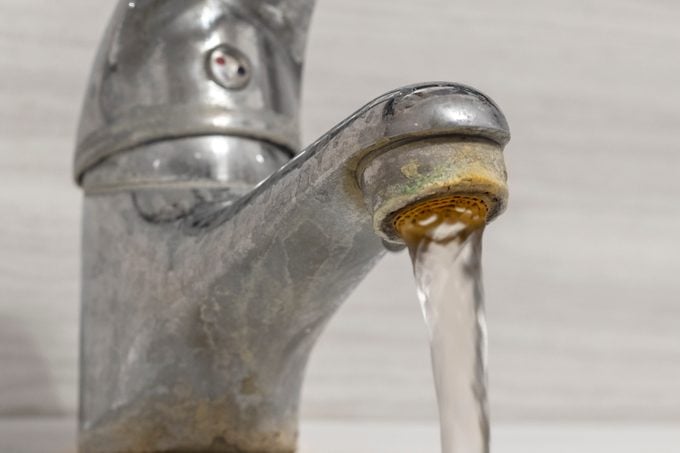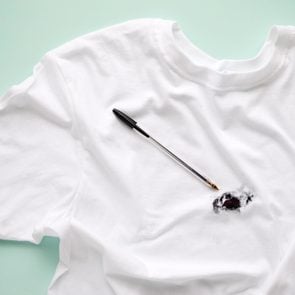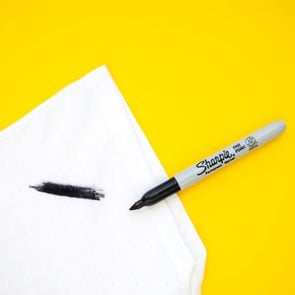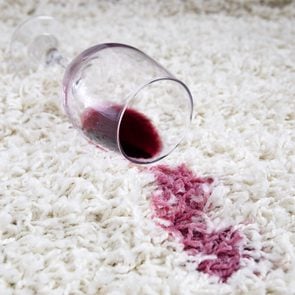How to Easily Remove Hard-Water Stains from Any Surface, According to Cleaning Pros
Updated: Apr. 19, 2024
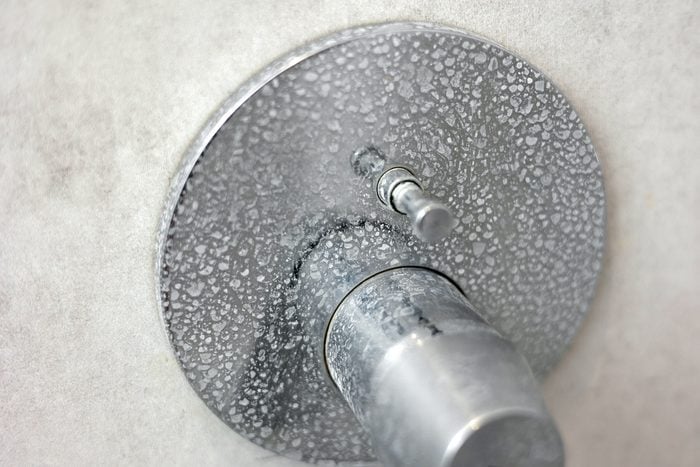
Cleaning experts offer the very best tips on how to remove hard-water stains from tubs, toilets, faucets, glass and dishes
Hard-water stains—those white, filmy residues that show up on everything from dishes to tubs to toilets—may be a burden, but they’re not permanent. In fact, there are many ways to remove hard-water stains (that actually work!) using common household ingredients. That’s good news, because even though hard water isn’t hazardous to your health, the stains are unsightly. If you’re looking to learn how to remove stains made by hard water, you’ve come to the right place.
For this piece, Reader’s Digest consulted three cleaning experts with decades of cleaning experience between them to help you in your quest to get rid of stubborn hard-water stains. (We also checked in with an appliance expert for a handy pro tip.) Whether you have hard-water stains on your glass shower doors or are dealing with the effect of hard water in the toilet, these smart tips for how to clean hard-water stains—plus advice on how to prevent them—will help you keep your home sparkling.
Get Reader’s Digest’s Read Up newsletter for more cleaning, humor, travel, tech and fun facts all week long.
About the experts
Reviewed for accuracy by: Ann Russell, TikTok’s “cleaning auntie” and the author of How to Clean Everything. |
What is hard water?
Hard water is water that’s high in dissolved minerals, mostly calcium and magnesium, according to the United States Geological Survey (USGS). Much of the country lives with hard water, so there’s no need to panic. It’s not bad for you, but hard water makes soaps less effective, so you’ll have to use more product to get the same results.
Then there are the stains. “Hard-water stains are high in minerals, which then leave behind a chalky residue on surfaces,” says Rosa Nogales-Hernandez, head of home cleaning at Valet Living.
Luckily, hard-water stains are not permanent. If they’re allowed to build up over time, however, you could end up with layers of scale in your bathroom plumbing or around the valves of your dishwasher—which could lead to costly repairs down the line. In other words: You have to regularly remove hard-water stains.
The best hard-water stain removers
Hard-water stains can be stubborn, but that doesn’t mean you have to use harsh cleaners to remove them. “Many households prefer DIY solutions due to their cost-effectiveness and minimal use of chemicals,” says Mattie Sheppard, a cleaning advisor for Real Estate Bees and the owner of her own cleaning and decluttering business.
Simple and natural homemade cleaners are the go-to for hard water, but we have pro-endorsed commercial recommendations too. Here are the most effective home remedies and products for removing hard-water stains:
White vinegar
Hands down, a simple white-vinegar-and-water mixture is the best hard-water stain remover, according to cleaning experts. “Our go-to product is and always will be white vinegar,” says Alicia Sokolowski, president and co-CEO of AspenClean. Vinegar contains acetic acid, which breaks down mineral deposits by attracting hard-water calcium and magnesium ions.
Sokolowski calls vinegar a nearly “perfect cleaning agent” due to its versatility, safety and cost-effectiveness—it’s just as effective at removing odors from clothes as it is at making hard-water stains disappear.
Vinegar’s easy to use too. “I have found that spraying a mixture of white vinegar and water onto the stained area, letting it sit for 15 minutes, then wiping it away will usually get rid of a hard-water stain.” It’s that simple!
Baking soda
Sheppard says a baking-soda paste—made by adding water to baking soda—can help scrub away hard-water stains. Baking soda’s gentle scrubbing power is abrasive enough to physically remove stains, and it won’t harm most surfaces. (But always test a small, inconspicuous area first, she says.)
Apply it directly to the hard-water stain, let it sit for a few minutes, then use a brush or cloth to gently scrub away the stain. Finish by flushing with water.
OxiClean Foam-Tastic
“For my home, I use [OxiClean] Foam-Tastic,” Nogales-Hernandez says. This popular foaming bathroom cleaner used to be called Kaboom Foam-Tastic, and Nogales-Hernandez says it “works wonders on soap scum, hard-water buildup, lime stains, calcium deposits and even grease,” taking the place of many different products in the pro cleaner’s home.
To use, spray it on the hard-water stain and let it sit until the formula turns white. Then wipe it—and the stain—right off.
Borax
A mixture of borax and vinegar will remove just about any hard-water stain—but it works especially well on toilet bowls. Borax is a naturally occurring mineral compound known for both its scrubbing and cleaning power. Combine vinegar and borax to make a paste that can be applied to hard-water stains around the bowl’s edges directly, or pour it right into the toilet bowl and let it sit before scrubbing.
How to remove hard-water stains from glassware and dishes
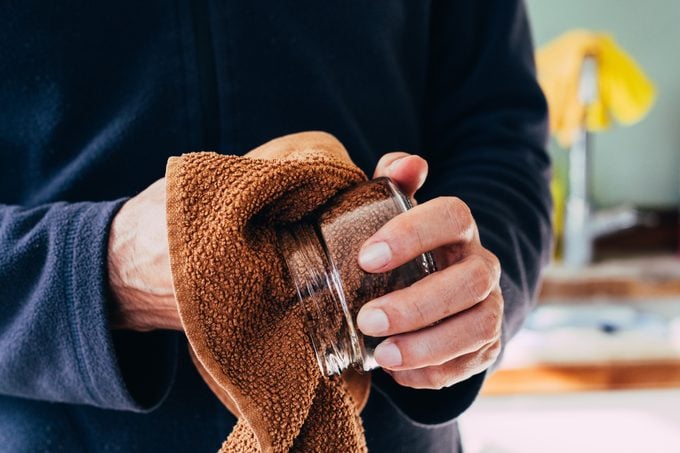
If your dishes come out of the dishwasher covered in spots, it’s not a case of you needing to clean your dishwasher. (Though it’s a good idea to do that anyway!) This is a case of hard water doing its thing.
Sokolowski and Sheppard have the solution to removing stubborn hard-water spots: white vinegar. Simply spray it on your glassware or dishes, let it work and then wipe it off—easy peasy.
Supplies you’ll need
- White vinegar (4% to 8% acidity)
- Spray bottle
- Microfiber cloth
Directions
- Add white vinegar to a spray bottle. If your vinegar is higher than 8% acidity, dilute it with an equal amount of water.
- Spray glasses and dishes with the vinegar.
- Let it sit for five to 15 minutes.
- Rinse, then wipe dry with a microfiber cloth.
Pro tip: A common recommendation for hard water is putting vinegar into your dishwasher’s rinse-aid compartment. That’s not a good idea, according to Haven Polich, product manager at Asko kitchen appliances. Vinegar is highly acidic, and “it can break down the rubber gaskets and hose in your dishwasher, leading to expensive repairs if used excessively,” Polich says.
How to remove hard-water stains from showers and tubs
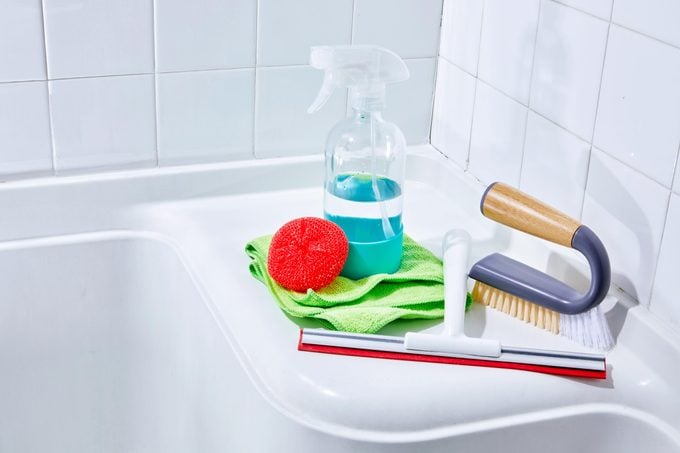
To get rid of hard-water stains on showers and tubs, a mixture of vinegar and water will do the trick, Nogales-Hernandez says. Time is key, so allow the vinegar to work for at least 15 minutes. (That’s true when tackling all your hard-water-stained surfaces, not just when cleaning showers and tubs.)
Supplies you’ll need
- White vinegar
- Spray bottle
- Nylon brush
Directions
- Mix equal parts vinegar and water in a spray bottle.
- Spray the shower and bathtub stains with the vinegar solution.
- Let it sit for 15 minutes, adding more if needed.
- Scrub with a brush to remove stains.
- Rinse and repeat if necessary.
How to remove hard-water stains from faucets and showerheads
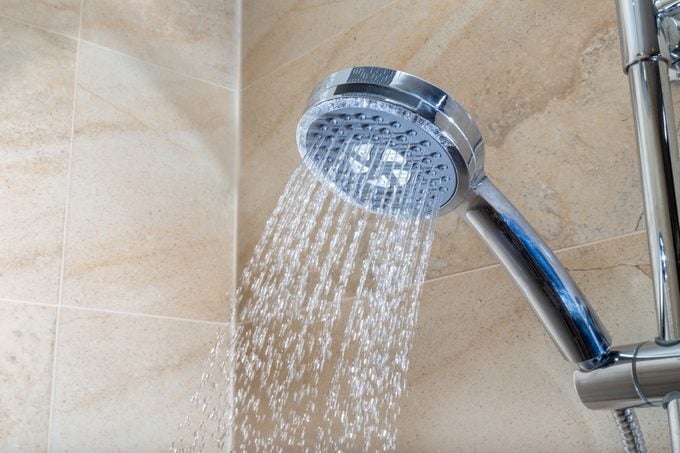
Regularly deep-cleaning your faucet heads and showerheads is a good idea, but if you’re simply trying to remove water spots (not fully de-gunk them), try this hack. You’ll be able to clean them without having to remove the faucet or showerhead first.
Supplies you’ll need
- White vinegar
- Small bowl
- Paper towels
Directions
- Mix equal parts vinegar and water in a small bowl.
- Dip paper towels into the mixture and gently squeeze so they’re not dripping.
- Wrap the paper towels around your faucet or showerhead, and let it sit for 15 minutes.
- Remove the paper towels and use them to wipe the stains away.
Pro tip: You can remove mineral buildup on your faucets and showerheads with monthly cleanings. But you should also deeply clean those showerheads and faucet heads every four months, or at least twice a year.
How to remove hard-water stains from glass
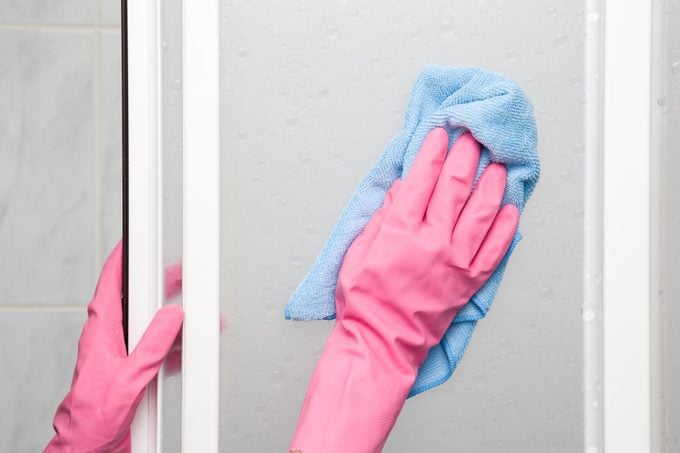
Glass shower doors and windows are a magnet for hard-water stains, but cleaning them is a snap. Vinegar once again should be your go-to, according to the experts.
Glass shower doors
Hate the unsightly water spots clouding your glass shower doors? Follow the pros’ steps to removing them and giving your shower a just-like-new feel.
Supplies you’ll need
- White vinegar
- Spray bottle
- Microfiber cloth
Directions
- Mix equal parts vinegar and water in a spray bottle.
- Spray the mixture liberally all over the doors, starting at the top and working your way toward the bottom.
- Let it sit for 15 minutes. Reapply the vinegar often as the solution runs down the doors.
- Wipe away stains with a microfiber cloth.
Windows
When the world outside your window is looking a little grimy, it’s time to break out the vinegar and clean your windows of stubborn hard-water stains. Take these steps to get them clear once again.
Supplies you’ll need
- White vinegar
- Spray bottle
- Old towel
- Paper towels or microfiber cloth
Directions
- Mix equal parts vinegar and water in a spray bottle.
- Place an old towel on the window sill to catch drips, or open and tilt the window inward if you have that option.
- Spray the mixture liberally on the window.
- Let it sit for 15 minutes. Reapply the vinegar if the solution dries or drips.
- Wipe away stains with a paper towel or microfiber cloth.
Pro tip: Instead of applying (and reapplying) the vinegar solution to the window, you can saturate the paper towels with the vinegar mix, then stick them on the window. They’ll hold the vinegar solution on the glass.
How to remove hard-water stains from toilets
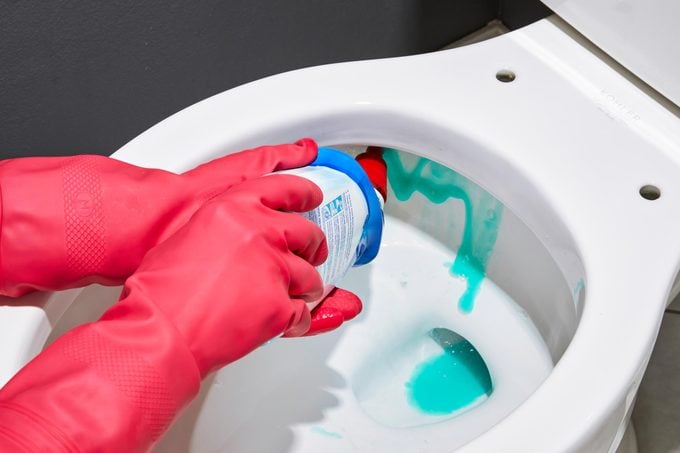
If you want to try a product specifically geared toward toilet bowls, Nogales-Hernandez suggests Lysol Power Toilet Bowl Cleaner because it easily breaks down hard-water stains. Still seeing a stain? The pro says it’s time to pull out the vinegar for a second round of toilet cleaning.
“If there is still a stain there, get that white-vinegar-and-water mixture, spray it on the stains and let it sit for 20-plus minutes,” Nogales-Hernandez says. “Then hit the stain with the toilet brush and flush the stains away.”
Supplies you’ll need
- Lysol Power Toilet Bowl Cleaner
- Toilet brush
- White vinegar (optional)
- Spray bottle (optional)
- Microfiber cloth or paper towel
Directions
- Apply a generous amount of Lysol Power Toilet Bowl Cleaner under the rim of your toilet bowl.
- Let the cleaner drip down so it covers all the hard-water stains. Apply more if needed.
- Let the solution sit for 15 minutes.
- Scrub with a toilet brush, then flush.
- Mix equal parts vinegar and water in a spray bottle.
- Apply the vinegar solution to stubborn stains.
- Let it sit for 20 minutes, then scrub.
- Flush and wipe down the toilet.
FAQs
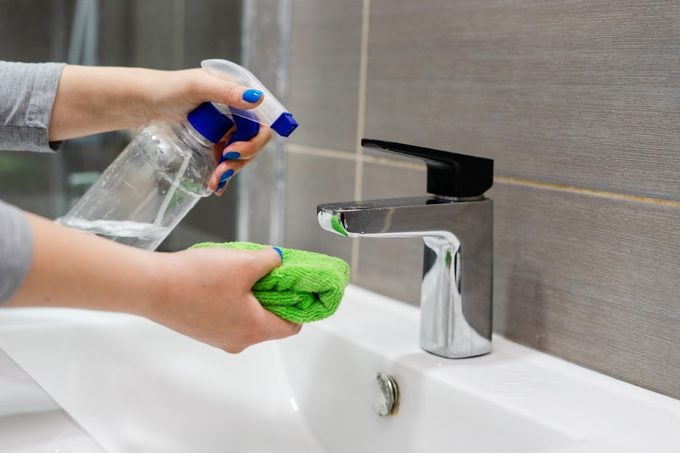
What causes hard water?
When rain and natural groundwater travel through layers of rock and soil, they dissolve and pick up hints of different water-soluble minerals—namely calcium and magnesium—as they go. Depending on the soil content where you live, your water may be hard or soft (aka have fewer minerals). The map from the U.S. Geological Survey’s National Water-Quality Assessment (NAWQA) Project makes it easy to see how water hardness levels vary across the United States.
How do you remove calcified hard-water stains?
For crusty hard water on porcelain, like toilets, tubs and sinks, try a pumice stone, sold commercially as a Pumie. They’re particularly popular for toilet rings. Dip the pumice stone into the water and scrub the scale away.
“Pumice stones are generally safe for use on porcelain, ceramic and other hard surfaces,” Sokolowski says. They’re not compatible with every surface in your home, though. You don’t want to use them on colored porcelain, she says. Follow the directions carefully, and test on an inconspicuous spot.
Does CLR bath cleaner remove hard-water stains?
Yes. CLR, which stands for “Calcium, Lime, Rust,” is a commercial acidic cleaner that removes hard-water stains and mineral deposits. It works on many household surfaces, including porcelain, glass, fiberglass and chrome. It’s a stronger acid than vinegar but still considered an EPA SaferChoice chemical. Always follow the directions on the bottle and wear appropriate safety gear.
How can you tell if you have hard water?
You can often tell you have hard water simply by witnessing its effects in your home, but there are ways to get an exact figure as well. Water hardness is measured on a scale from soft to very hard, based on how many milligrams (mg) of calcium carbonate are found in one liter (L) of water. According to the USGS, water hardness ranges from soft (0 to 60 mg/L) to very hard (180 mg and up).
Here are ways you can test or observe your home’s water hardness:
- Buy an inexpensive water hardness test kit online or at your local home improvement center.
- Call your local water utility. Municipalities monitor water hardness levels due to the risk of scale and destructive buildup.
- Check dishes and glasses as soon as they come out of the dishwasher. If there’s cloudiness or spots on them, you have hard water.
- Pay attention when you wash your hands and clothing. Do your hands have a soapy or filmy residue after rinsing? Do your towels seem dingy or stiff?
- Put 10 drops of liquid dish soap into a half-filled bottle of water and shake it up. If only a thin layer of suds form (versus a whole lot), you have hard water.
How can you prevent hard-water stains?
Installing a water-softening system is your best long-term solution. These systems filter your water before it comes into your home. During the filtration process, negatively charged particles in the filtration system attract the positively charged calcium and magnesium ions so they get removed from your water.
Hard water builds up in pipes and reduces your water pressure, but since hard water isn’t harmful to your health, spending hundreds or thousands of dollars for a water-softening system may not be your top priority. Aside from the long-term solution, keep hard-water stains away by preventing water from pooling, dripping or evaporating on surfaces. Wipe up spills and fix leaky faucets so they don’t drip hard water, which builds up. Drain and dry tubs after use. “Reducing the amount of time that water sits in the tub will reduce the buildup of stains,” Nogales-Hernandez says.
Another professional cleaning tip? Get a shower squeegee. “[It] will do wonders for the glass doors,” she says. “And it only takes a minute to do!”
Why trust us
At Reader’s Digest, we’re committed to producing high-quality content by writers with expertise and experience in their field in consultation with relevant, qualified experts. For this piece, Maryn Liles tapped her years of experience writing about home and cleaning topics, and then Ann Russell, TikTok’s “cleaning auntie” and the author of How to Clean Everything, gave it a rigorous review to ensure that all information is accurate and offers the best possible advice to readers. For this piece, we relied on reputable primary sources, including governmental organizations as well as our writers’ personal experience. We verified all facts and data and backed them with credible sourcing, and we will revisit them over time to ensure they remain accurate and up to date. Read more about our team, our contributors and our editorial policies.
Sources:
- Rosa Nogales-Hernandez, head of home cleaning at Valet Living
- Haven Polich, product manager at Asko appliances; email interview, Jan. 5, 2024
- Mattie Sheppard, cleaning advisor at Real Estate Bees; email interview, Jan. 7, 2024
- Alicia Sokolowski, president and co-CEO of AspenClean; email interview, Jan. 4, 2024
- U.S. Geological Survey: “Hardness of Water”
- Environmental Protection Agency: “Safer Choice”

